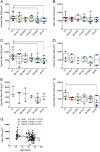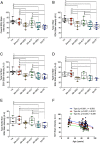The impact of ageing, physical activity, and pre-frailty on skeletal muscle phenotype, mitochondrial content, and intramyocellular lipids in men
- PMID: 27897402
- PMCID: PMC5377417
- DOI: 10.1002/jcsm.12139
The impact of ageing, physical activity, and pre-frailty on skeletal muscle phenotype, mitochondrial content, and intramyocellular lipids in men
Abstract
Background: The exact impact of ageing on skeletal muscle phenotype and mitochondrial and lipid content remains controversial, probably because physical activity, which greatly influences muscle physiology, is rarely accounted for. The present study was therefore designed to investigate the effects of ageing, physical activity, and pre-frailty on skeletal muscle phenotype, and mitochondrial and intramyocellular lipid content in men.
Methods: Recreationally active young adult (20-30 yo; YA); active (ACT) and sedentary (SED) middle-age (50-65 yo; MA-ACT and MA-SED); and older (65 + yo; 65 + ACT and 65 + SED) and pre-frail older (65 + PF) men were recruited. Muscle biopsies from the vastus lateralis were collected to assess, on muscle cross sections, muscle phenotype (using myosin heavy chain isoforms immunolabelling), the fibre type-specific content of mitochondria (by quantifying the succinate dehydrogenase stain intensity), and the fibre type-specific lipid content (by quantifying the Oil Red O stain intensity).
Results: Only 65 + SED and 65 + PF displayed significantly lower overall and type IIa fibre sizes vs. YA. 65 + SED displayed a lower type IIa fibre proportion vs. YA. MA-SED and 65 + SED displayed a higher hybrid type IIa/IIx fibre proportion vs. YA. Sedentary and pre-frail, but not active, men displayed lower mitochondrial content irrespective of fibre type vs. YA. 65 + SED, but not 65 + ACT, displayed a higher lipid content in type I fibres vs. YA. Finally, mitochondrial content, but not lipid content, was positively correlated with indices of muscle function, functional capacity, and insulin sensitivity across all subjects.
Conclusions: Taken altogether, our results indicate that ageing in sedentary men is associated with (i) complex changes in muscle phenotype preferentially affecting type IIa fibres; (ii) a decline in mitochondrial content affecting all fibre types; and (iii) an increase in lipid content in type I fibres. They also indicate that physical activity partially protects from the effects of ageing on muscle phenotype, mitochondrial content, and lipid accumulation. No skeletal specific muscle phenotype of pre-frailty was observed.
Keywords: Atrophy; Exercise; Human muscle ageing; Lipid content; Mitochondria; Sarcopenia.
© 2016 The Authors. Journal of Cachexia, Sarcopenia and Muscle published by John Wiley & Sons Ltd on behalf of the Society on Sarcopenia, Cachexia and Wasting Disorders.
Figures





Similar articles
-
Physical activity unveils the relationship between mitochondrial energetics, muscle quality, and physical function in older adults.J Cachexia Sarcopenia Muscle. 2018 Apr;9(2):279-294. doi: 10.1002/jcsm.12272. Epub 2018 Jan 24. J Cachexia Sarcopenia Muscle. 2018. PMID: 29368427 Free PMC article.
-
Preservation of skeletal muscle mitochondrial content in older adults: relationship between mitochondria, fibre type and high-intensity exercise training.J Physiol. 2017 Jun 1;595(11):3345-3359. doi: 10.1113/JP273950. Epub 2017 Apr 23. J Physiol. 2017. PMID: 28251664 Free PMC article.
-
Structure and function of human muscle fibres and muscle proteome in physically active older men.J Physiol. 2017 Jul 15;595(14):4823-4844. doi: 10.1113/JP274148. Epub 2017 Jun 5. J Physiol. 2017. PMID: 28452077 Free PMC article.
-
The role of weight loss and exercise in correcting skeletal muscle mitochondrial abnormalities in obesity, diabetes and aging.Mol Cell Endocrinol. 2013 Oct 15;379(1-2):30-4. doi: 10.1016/j.mce.2013.06.018. Epub 2013 Jun 20. Mol Cell Endocrinol. 2013. PMID: 23792186 Review.
-
Mitochondrial function, fibre types and ageing: new insights from human muscle in vivo.Exp Physiol. 2007 Mar;92(2):333-9. doi: 10.1113/expphysiol.2006.034330. Epub 2006 Dec 14. Exp Physiol. 2007. PMID: 17170059 Review.
Cited by
-
Effects of Aging and Caloric Restriction on Fiber Type Composition, Mitochondrial Morphology and Dynamics in Rat Oxidative and Glycolytic Muscles.Front Physiol. 2019 Apr 24;10:420. doi: 10.3389/fphys.2019.00420. eCollection 2019. Front Physiol. 2019. PMID: 31114501 Free PMC article.
-
Impact of physical activity on physical function, mitochondrial energetics, ROS production, and Ca2+ handling across the adult lifespan in men.Cell Rep Med. 2025 Feb 18;6(2):101968. doi: 10.1016/j.xcrm.2025.101968. Epub 2025 Feb 10. Cell Rep Med. 2025. PMID: 39933528 Free PMC article.
-
Untargeted metabolomics for uncovering biological markers of human skeletal muscle ageing.Aging (Albany NY). 2020 Jun 24;12(13):12517-12533. doi: 10.18632/aging.103513. Epub 2020 Jun 24. Aging (Albany NY). 2020. PMID: 32580166 Free PMC article.
-
Navigating the Landscape of Translational Geroscience in Canada: A Comprehensive Evaluation of Current Progress and Future Directions.J Gerontol A Biol Sci Med Sci. 2024 Jul 1;79(7):glae069. doi: 10.1093/gerona/glae069. J Gerontol A Biol Sci Med Sci. 2024. PMID: 38486371 Free PMC article.
-
Which one came first: movement behavior or frailty? A cross-lagged panel model in the Toledo Study for Healthy Aging.J Cachexia Sarcopenia Muscle. 2020 Apr;11(2):415-423. doi: 10.1002/jcsm.12511. Epub 2020 Jan 8. J Cachexia Sarcopenia Muscle. 2020. PMID: 31912990 Free PMC article.
References
-
- Janssen I, Heymsfield SB, Ross R. Low relative skeletal muscle mass (sarcopenia) in older persons is associated with functional impairment and physical disability. J Am Geriatr Soc 2002;50:889–896. - PubMed
-
- Rosenberg IH. Sarcopenia: origins and clinical relevance. J Nutr 1997;127:990S–991S. - PubMed
-
- Barbat‐Artigas S, Rolland Y, Cesari M, Abellan van Kan G, Vellas B, Aubertin‐Leheudre M. Clinical relevance of different muscle strength indexes and functional impairment in women aged 75 years and older. J Gerontol A Biol Sci Med Sci 2013;68:811–819. - PubMed
-
- Eddinger TJ, Moss RL, Cassens RG. Fiber number and type composition in extensor digitorum longus, soleus, and diaphragm muscles with aging in Fisher 344 rats. J Histochem and Cytochem official J Histochem Society 1985;33:1033–1041. - PubMed
MeSH terms
Substances
Grants and funding
LinkOut - more resources
Full Text Sources
Other Literature Sources
Medical

